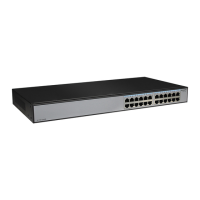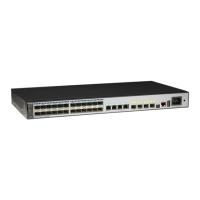area area-id
The OSPF area view is displayed.
The OSPF areas can be classified into a backbone area with the area ID of 0 and non-backbone
areas. The backbone area is responsible for forwarding inter-area routing information. The
routing information between the non-backbone areas must be forwarded through the backbone
area.
Step 4 Run:
network ip-address wildcard-mask [ description text ]
The network segments are configured to belong to the area. description is used to configure a
description for the specified OSPF network segment.
OSPF can run on an interface properly only when the following conditions are met:
l The mask length of the IP address of an interface is greater than or equal to that specified by
the network command.
l The primary IP address of an interface is on the network segment specified by the
network command.
By default, OSPF uses a 32-bit host route to advertise the IP address of a loopback interface. To
advertise routes to the network segment of the loopback interface, configure the network type
as NBMA or broadcast in the interface view. For details, see Configuring Network Types for
OSPF Interfaces.
----End
4.3.3 (Optional) Creating OSPF Virtual Links
This section describes how to create logical links between backbone areas to ensure the OSPF
network connectivity.
Context
After OSPF areas are defined, OSPF route updates between non-backbone areas are transmitted
through a backbone area. Therefore, OSPF requires that all non-backbone areas maintain the
connectivity with the backbone area and the backbone areas in different OSPF areas maintain
the connectivity with each other. In real world situations, this requirement may not be met
because of some restrictions. To resolve this problem, you can configure OSPF virtual links.
Perform the following steps on the switch running OSPF.
Procedure
Step 1 Run:
system-view
The system view is displayed.
Step 2 Run:
ospf [ process-id ]
The OSPF process view is displayed.
Step 3 Run:
area area-id
S6700 Series Ethernet Switches
Configuration Guide - IP Routing 4 OSPF Configuration
Issue 01 (2012-03-15) Huawei Proprietary and Confidential
Copyright © Huawei Technologies Co., Ltd.
92

